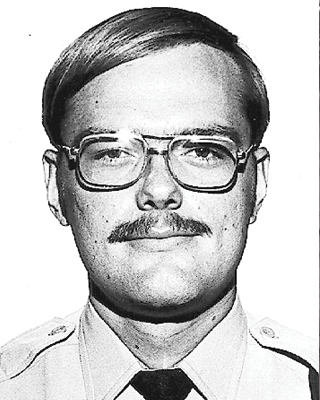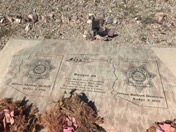
Main navigation

Richard G. Stratman
End of Watch: Sunday, October 2, 1983
Badge: 1622
Age: 27
Officer/Paramedic Richard G. Stratman, along with Pilot Thomas McNeff, was in a departmental helicopter when it crashed in a cotton field near Marana. The two men died in the crash.
On Sunday, October 2, 1983, just before 1:00 a.m., Arizona Department of Public Safety (AZDPS) officer/pilot Thomas McNeff, along with AZDPS officer/paramedic Richard Stratman died when their helicopter [Ranger 29] crashed into a flooded cotton field in Marana, Arizona. At the time, southern Arizona was experiencing historic thunderstorms with heavy rainfall and flooded many areas, including the crash site. The cotton field was underwater due to the overflowing Santa Cruz River nearby. First responders to the crash estimated the floodwater depth to be between one to five feet and that it was too dangerous to reach by ground.
Pilot McNeff went on duty Saturday, October 1, at 6:00 a.m. Paramedic Stratman went on duty at 8:00 a.m. The two-person crew flew numerous times over an 11 ½ hour span to support search and rescue, medical, flood reconnaissance, and other flood-related missions on one of the Department’s helicopters – Ranger 29.
Most of the rescue operations supported the Pima County Sheriff’s Office and Picture Rocks/Avra Valley Fire Department. One news source reported that the Ranger 29 crew rescued over 30 people from the rooftops of homes inundated by flood waters, from vehicles caught in various washes/rivers, and from high-ground areas people escaped to during the historic flooding surrounding the Tucson metropolitan area.
Among the missions that Ranger 29 conducted was transporting a pregnant woman, Kelly Amick, from the Twin Peaks market west of Marana to the University of Arizona Medical Center. Due to flooding in the area, timely ground transportation to a hospital was impossible.
In another emergency call, three Picture Rocks/Avra Valley volunteer firefighters became stranded on their fire attack truck within the Santa Cruz River. The Ranger 29 crew was not able to complete the rescue due to high tension power lines and other fixed lines high up around the area of the stranded firefighters. Any rescue attempt in the dark stormy night, with the power and landline obstacles, would have been extremely hazardous to the firefighters and the Ranger 29 crew. After several attempts, the mission was aborted.
Ranger 29 lifted off from the intersection of Silverbell and Aguirre, the aborted rescue site, and flew towards Tucson International Airport, where the DPS Southern Air Rescue hangar was located. Ranger 29 never made it to the hangar; instead, it crashed less than ten minutes later, just six nautical miles southeast of its take-off point, between 12:45 and 12:55 a.m.
Pilot McNeff’s last radio transmission was at 12:45:41 a.m. The transmission was, “MEDS; Ranger 29, we hear you, but we’re gonna be real busy.” “The MEDS Dispatcher did not perceive any indication of a problem with either the pilot or aircraft based on the voice inflection of the pilot,” according to the official Department report.
At 12:50 a.m., Lt. Williams of the Pima County Sheriff’s Office (PCSO), called the DPS communications center to report Ranger 29 had crashed. According to the official DPS report, “The DPS Dispatcher told Lt. Williams, ‘No, MEDS just talked to him [Ranger 29] at 12:45 a.m.’ Lt. Williams said to the dispatcher, ‘Went down and exploded in Marana. Yours was the only one [helicopter] in the area’”
PCSO requested a U.S. Air Force search and rescue team to respond to the crash site. Two pilots, a flight surgeon, and a flight mechanic, flew through a storm cell to reach Ranger 29. The pilot-in-charge described having encountered several rain squalls, heavy rain showers, and whiteouts from their spot/searchlights reflecting into the cockpit from the heavy rain. The pilot also experienced spatial disorientation, prompting him to trade control of the helicopter to the co-pilot repeatedly. At 1:55 a.m., the flight mechanic spotted the wreckage of Ranger 29. The flight surgeon was lowered to the crash site and determined there were no signs of life. Flood waters prevented the flight surgeon from getting close to Ranger 29. A weather front moved in over the crash site, forcing the team to leave the area until daybreak. The pilot reported Ranger 29 crashed into the flooded cotton field – nose first and at a slight left bank/angle.
The exact cause of the crash was never determined. The official report lists several possibilities, including pilot error, bad weather, or an aircraft failure.
Officer/Pilot Thomas McNeff was a U.S. Army gunship pilot with the 192nd Assault Helicopter Company in Phan Thiet during the Vietnam War from 1970 – 1971. He had been with the Department for eight years and was 36. His daughter and his parents survived him.
Officer/Paramedic Richard Stratman was a DPS explorer as a teenager and eventually followed his dream to become a DPS officer. After a year-long training course, Stratman became a paramedic in 1979. He was 27 years old and is survived by his parents.
The Thomas P. McNeff #1758 and Richard G. Stratman #1622 memorials are located on the eastbound I-10 ramp at milepost 236.
.
